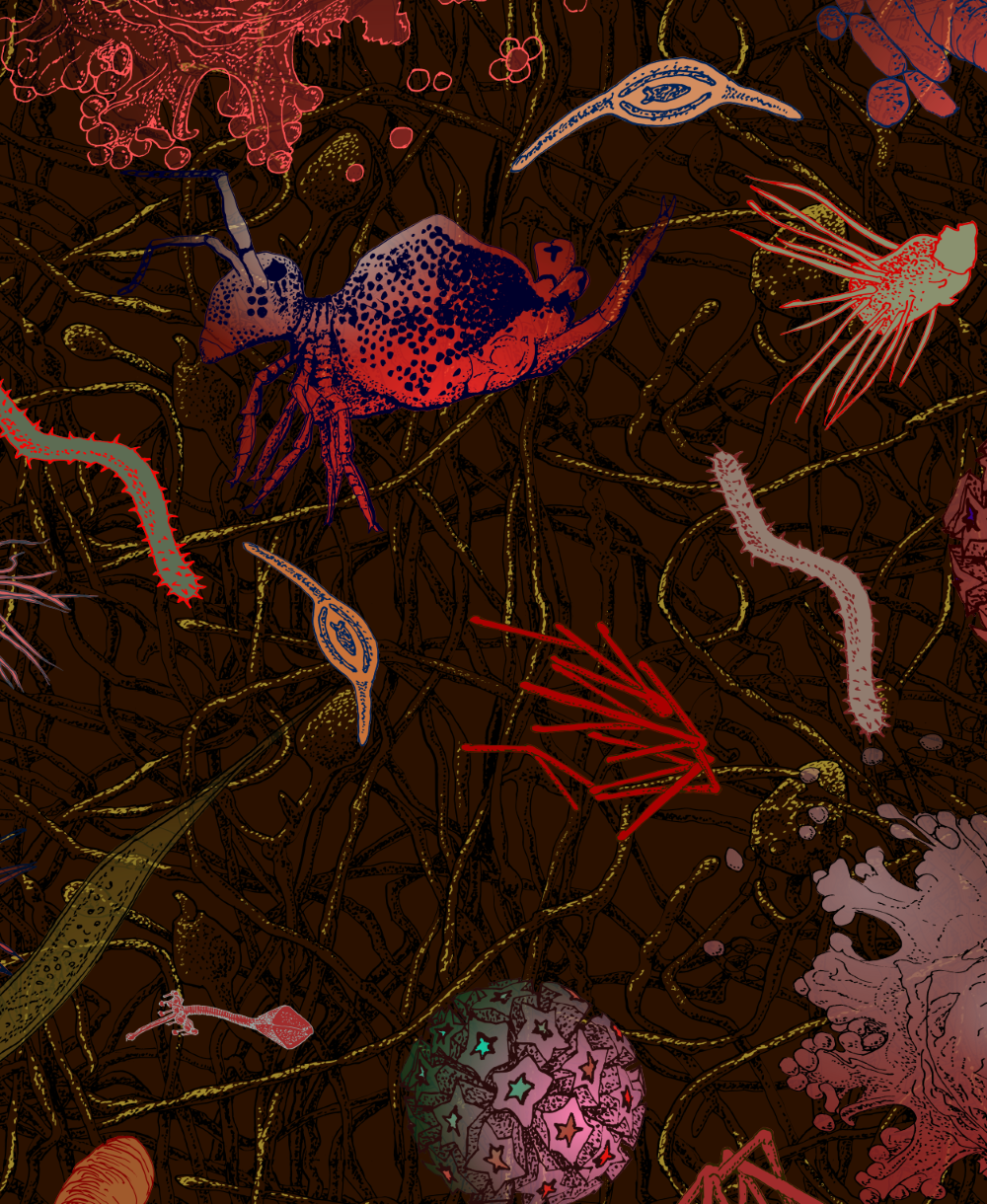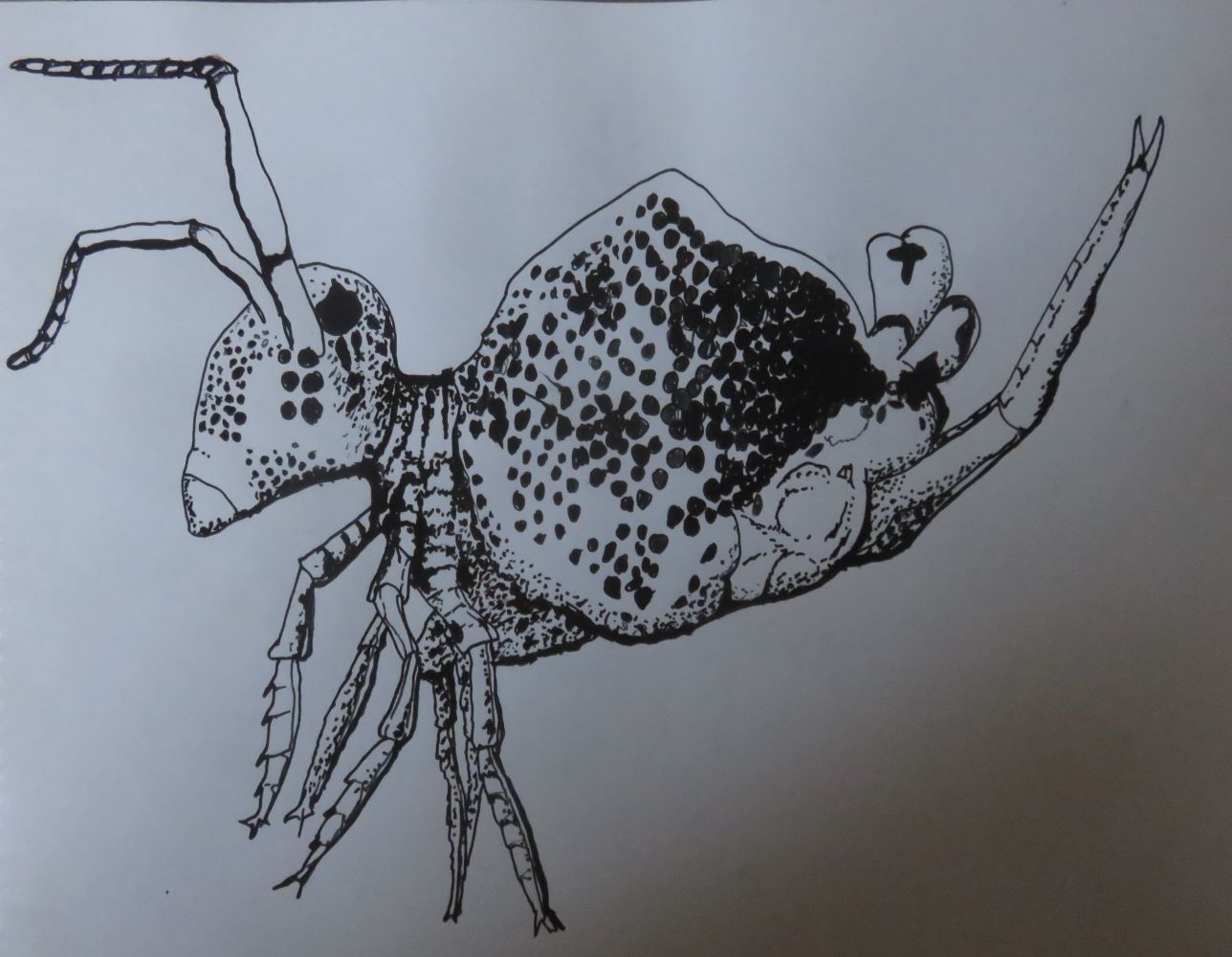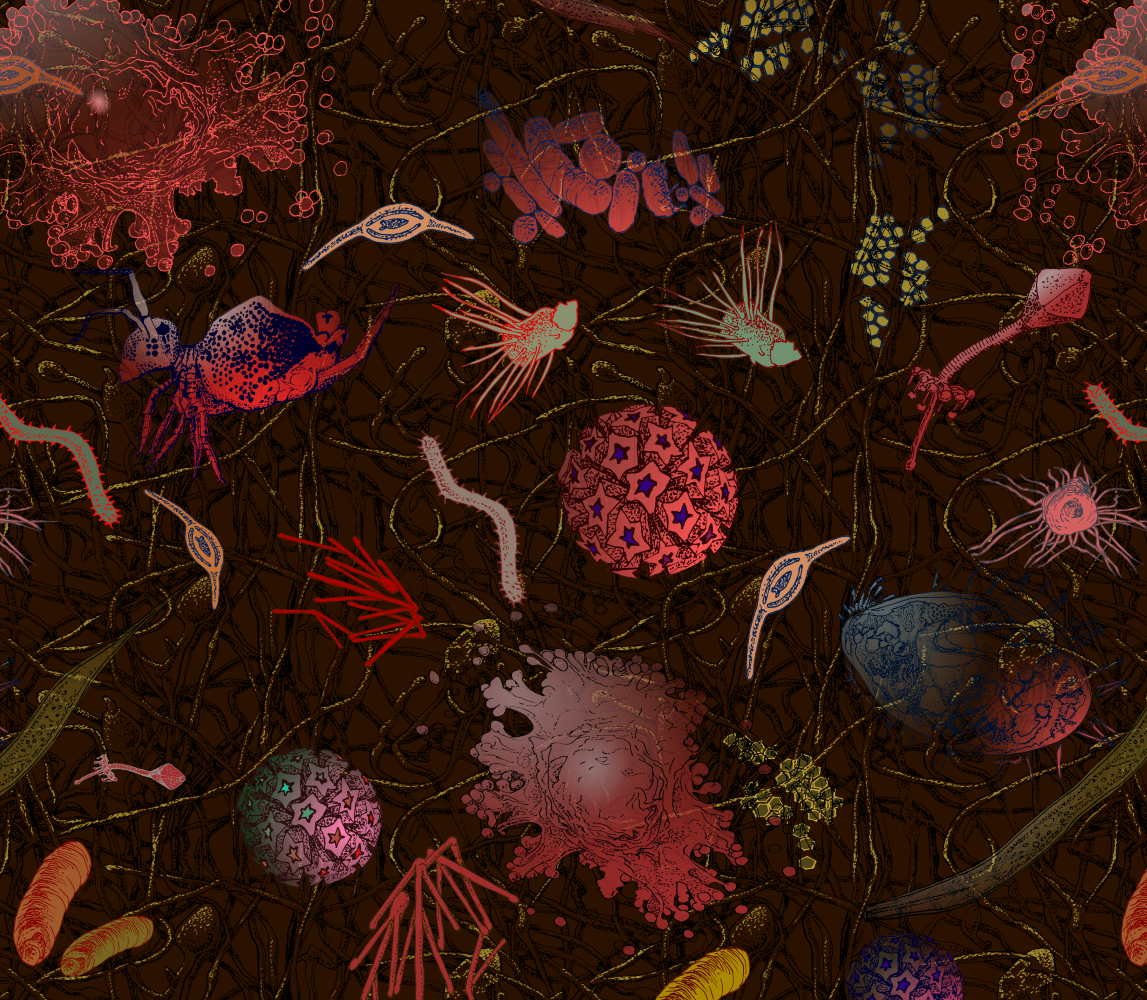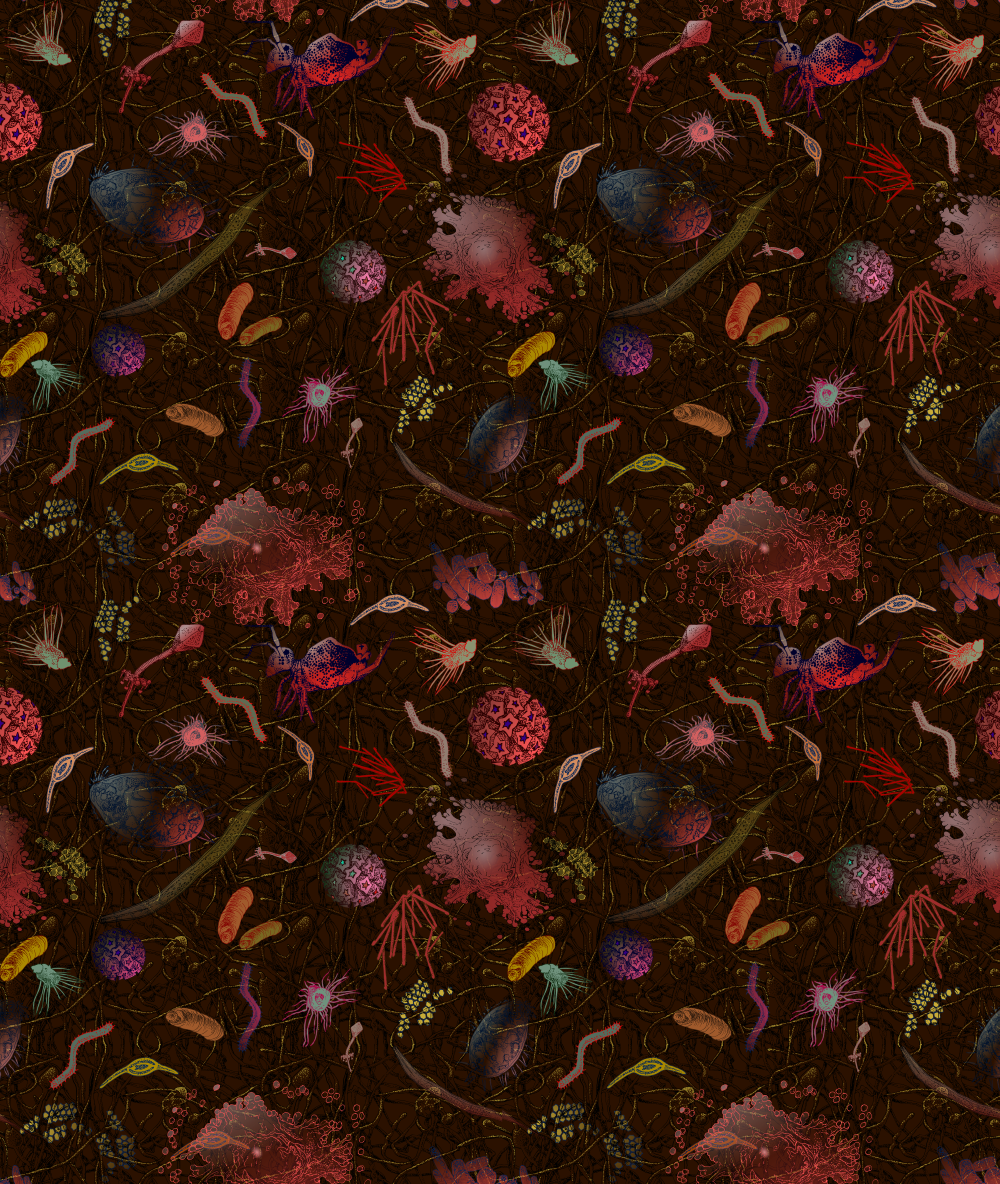Dear Reader, in this age of AI created content, please support with your goodwill someone who works harder to provide the human-made. Sign up at the top of the lefthand column or bottom of this page. You will receive my hand illustrated monthly newsletter RESTORE NATURE and access to the biodiversity garden design course as I write...and nothing else, I respect your time. I am also removing the advertizing as best I can as its become intrusive inappropriate and pays me nothing.
Soil microbe design: traveling to under space to meet the aliens beneath our feet
 The soil microbe design shows the artist's rendition of the transparency and intricate structures of soil organisms.
The soil microbe design shows the artist's rendition of the transparency and intricate structures of soil organisms.I had enormous satisfaction from doing this design. It was partly the invigorating experience of doing new things and partly that it's of ideological importance, creating positive propaganda for soil health.
Kiss the Ground Soil Advocacy seminars and then a Udemy course in Soil Microscopy by Dr Mary Lucero got me really wanting to look at this fascinating world so new to me it could have been on another planet. There is also a lovely and imaginative podcast about soil microbiology in English from FU Berlin that I would recommend if you want to be inspired.
The journey into another dimension to meet soil microbes begins
I borrowed a microscope and started. There was
nothing visible in most of my garden soil, but the magnification of
my microscope is very low, only 40X. I thought the magnification was
causing this problem until I looked in the worm bin and saw lots of
fungal hyphae. Then I looked at the soil in my gray water wetland !
It was teeming with life, such as protists that looked like purple
wine glasses, and others like emerald green snakes. There were
nematodes everywhere doing their coiling dance and I even saw a
micro arthropod with a lovely transparent thorax. Turning off the
microscope I looked at the tiny drops of water which contained this
metropolis of wonder peopled by so much diversity. I was aware for
the first time of the genocide committed by wiping the slide with a
tissue, but I can't get around it for the present.I only have two slides !
Then I tried to identify what I'd seen by googling and found out that this is still an unknown frontier. Most of the organisms have no names or identification. However, on the internet I came across many wonderful microscope photographs and decided to use some of them for my soil microbe design.
How the soil microbe design was made
I drew ink and pen studies of the microbes and then scanned them and converted the scans to vector files and began to color them with the available drawing tools in my drawing software called Inkscape. I tried to bring out the transparency and intricate detail and the shadowy chiaroscuro observed in my experience looking down the microscope. All in all the soil microbe design took me about a month of drawing and then manipulating the drawings.
 My pen drawing of one of the bizarre and wonderful creatures in the soil, the spring-tail. At only one to two millimeters in length it is still near the apex of a massive food web, teaming with very small creatures in vast numbers. See if you can find it in the soil microbe design.
My pen drawing of one of the bizarre and wonderful creatures in the soil, the spring-tail. At only one to two millimeters in length it is still near the apex of a massive food web, teaming with very small creatures in vast numbers. See if you can find it in the soil microbe design.Why I chose to base a design on soil microbes
This soil microbe design is the most important to me of any design I've done so far and for the reasons that follow below.
It represents the six major phyla of soil organisms, viruses, bacteria and archaea, protists, fungi, nematodes and micro arthropods. The creatures cannot be represented to scale as some are so tiny. So the size and the color of these organisms is somewhat distorted by artistic license. I hope That by making designs featuring this world that is invisible to our naked eyes, that people will become more conscious of soil microbes and grow to love them as much as large game animals, because microbes also need to be saved from extinction.
The loss of an apex predator can severely compromise ecosystems. For example the loss of wolves may have led to the loss of forest in Scotland, because deer eat away all the saplings. However the loss of the diversity of soil organisms could make life as we know it on earth impossible.
 In this close up you can see most of the creatures in the soil microbe design, representing the six big groups of organisms found in the soil.
In this close up you can see most of the creatures in the soil microbe design, representing the six big groups of organisms found in the soil.Soil microbes and food security
Soil microbes build what is called the soil sponge, by exuding glues like glomalin which form aggregates that allow more pore space. They also feed plants. We eat the plants that the soil feeds, and without the soil biology there will be massive human hunger and death.
Soil microbes make
nutrients available to plants in forms they can absorb. They recycle
nutrients in the soil, and fix nitrogen which plants need for strong
vegetative growth. Soil fungi massively increase the surface area of
roots, and they transport nutrients and water from place to place which
helps plants get adequate nutrition. The soil sponge conserves water,
increases surface area and the possibility of plant favorable chemical reactions in the soil,
allows roots to grow easily and prevents soil erosion. We are losing
top soil at a level that is bringing on a crisis, but nurturing the soil
sponge can reverse this process by creating soil.
Soil microbes, global warming and the water cycle
The soil sponge is also responsible for maintaining life as we know it on earth because of the multiple ecosystem functions it performs relating to water. The soil sponge and the life in it clean ground water, both through filtering it and processing toxins. Bacteria and fungi can even break down petrochemicals. When the water that reaches the rivers is cleaner, there will be healthier oceans. The oceans are massive buffers that ameliorate our climate extremes, and create the oxygen we breathe, and they are heavily impacted by atmospheric carbon, toxic pollution and warming.
The sponge's ability to buffer
and normalize water flows is created by its sponge like nature. The
ability of the sponge to soak up water leads to reduced
flooding and that also reduces erosion.
The sponge's ability to give plants a more stable supply of water creates healthy hydrology, driving the earth's evaporation and condensation related cooling system, which brings cooler global temperatures, sufficient and timely rain, forest health, functional river systems and perennial springs. Much of the effect of global warming is driven not by CO2 but by the loss of soil microbes and the soil sponge and its negative effect on hydrology. The climate groups focus on CO2 rather than water because its effects are less complex and simpler to quantify according to the climate scientist Walter Jehne.
I hope you can now see that its not far fetched to say that the tiny microscopic organisms in the soil beneath our feet can save the planet. Yet we know so little about them, and their diversity and quantity is staggering.
 The soil microbe design is a seamless repeat. The edge of the repeat goes right through some of them. Can you spot where ?
The soil microbe design is a seamless repeat. The edge of the repeat goes right through some of them. Can you spot where ?We are losing our soil microbes
Globally there is a drop in the diversity of microscopic life, just as there is a drop in the diversity of larger species. This is due to ploughing, biocides, and loss of natural space to urban and farming development.
Why do we need the diversity ? Because it is a balancing mechanism, and with less diversity the whole system is less resilient and tends to get out of balance, and allows the proliferation of pathogens, for one.
The diversity is also a pool of possibility. As an illustration, Dr Mary Lucero points out why we do not need GMO. Bacteria modify their genes to adapt to change faster than any laboratory can produce new variants, because of their rate of reproduction and short life spans, and they do it naturally, and under the process of natural selection which eliminates malfunctioning genes. It is thus much safer for us. Knock back that microbial diversity and you knock back the possibility of microbial adaption and the chances of survival way up the food chain to us. We need microbial diversity because we are more microbe than human.
We need to begin to think ecologically, of whole systems, in order to survive. But the way we've done our thinking till now is in the silos of the different disciplines, which have different intentions, with little cross fertilization, making us unconscious of the harmful effects of our actions on something we don't understand or see.
To find out more about how to nurture your soil, read my regenerative gardening blog, and do research on regenerative agriculture and soil health.
------
home page for lots of articles on natural gardening
------
our flora and fauna printed textiles
Restore Nature Newsletter
I've been writing for four years now and I would love to hear from you
Please let me know if you have any questions, comments or stories to share on gardening, permaculture, regenerative agriculture, food forests, natural gardening, do nothing gardening, observations about pests and diseases, foraging, dealing with and using weeds constructively, composting and going offgrid.
SEARCH
Order the Kindle E-book for the SPECIAL PRICE of only
Prices valid till 30.09.2023
Recent Articles
-
garden for life is a blog about saving the earth one garden at a time
Apr 18, 25 01:18 PM
The garden for life blog has short articles on gardening for biodiversity with native plants and regenerating soil for climate amelioration and nutritious food -
Cape Flats Sand Fynbos, Cape Town's most endangered native vegetation!
Apr 18, 25 10:36 AM
Cape Flats Sand Fynbos, a vegetation type found in the super diverse Cape Fynbos region is threatened by Cape Town's urban development and invasive alien plants -
Geography Research Task
Jan 31, 25 11:37 PM
To whom it may concern My name is Tanyaradzwa Madziwa and I am a matric student at Springfield Convent School. As part of our geography syllabus for this
"How to start a profitable worm business on a shoestring budget
Order a printed copy from "Amazon" at the SPECIAL PRICE of only
or a digital version from the "Kindle" store at the SPECIAL PRICE of only
Prices valid till 30.09.2023







